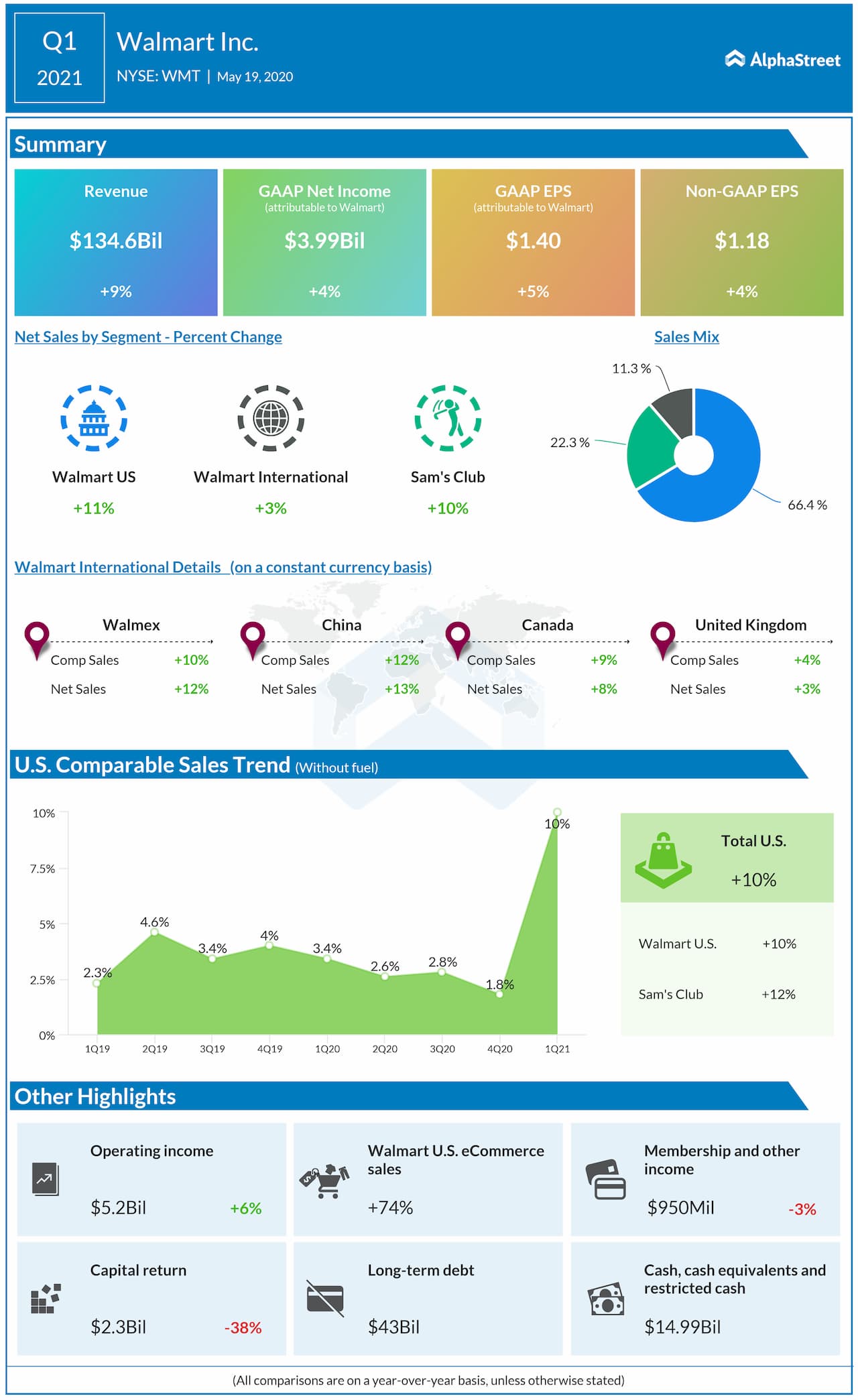The catastrophe unleashed by coronavirus has crippled almost all industries, but it has been business as usual or even better at Walmart (NYSE: WMT) as people stocked up on essential supplies in the early days of the pandemic and continued to use the retail giant’s omnichannel platform.
[irp posts=”62527″]
After a short-lived initial dip, the stock bounced back and climbed to a record high in mid-April as investor sentiment remained upbeat. The resilience – thanks to the strong fundamentals – and the decent dividends make the stock attractive to investors. Data shows the company returned more than $11 billion to shareholders in the last fiscal year. Not surprisingly, most analysts recommend buying the stock, anticipating the uptrend to continue.

Though the business world is limping back to normal after the authorities lifted the curbs, the persistent market volatility points to a cloudy future, which is the main reason behind the withdrawal of the full-year outlook by Walmart’s management. Meanwhile, an emerging trend that is clearly visible is a shift in people’s shopping patterns.
Changing Times
Will the market turmoil be a test for Walmart at a time when the retail space is witnessing a rapid transformation, with e-commerce firms driving customers en masse to their platforms? The Arkansas-based company is probably better equipped than its peers to provide a seamless experience to customers, by effectively linking its physical stores with the digital platform.
The acquisition of India-based Flipkart, coinciding with the sale of certain South American subsidiaries, was a major step towards expanding the market share. At the end of fiscal 2020, Walmart operated as many as 11,501 stores, reaffirming its global dominance.
Customer First
Being a trusted and socially committed brand, Walmart enjoys the patronage of a large number of households across the world. It has been constantly innovating, with the latest initiatives being the launch of the Next-Day delivery and In-Home delivery services. While the company has been successful in retaining customers with competitive pricing, the strategy could be challenged in the post-crisis world where improved operating efficiency will allow online retailers to offer better prices.
Recently, in a letter addressed to shareholders, Walmart’s chief executive officer Doug McMillon said, “We’ve seen the focus of our customers, in-store and online, a shift from stocking up and health and wellness, to entertaining and educating, to home improvement, to preparing to go back to work. Our purpose of saving people money and helping them live a better life has been even more tangible and meaningful to us during this period.”
Competition
Going forward, the big-box retailer will be required to use significant resources to tackle competition in the overcrowded retail sphere, both from traditional store operators and online players like Amazon (AMZN) which continues to be a formidable rival. Walmart’s capital plan is reflective of its aggressive digital push, with no new store on the cards and earmarking most of the funds for technology, e-commerce, and supply chain.
But in the near term, online-only retailers might get an advantage by eliminating the additional costs related to sanitization and safety precautions that traditional store operators incur.
The main topics Walmart discussed in social media in recent times were its pharmacy services business and participation in the campaign against racism. Incidentally, they are linked to the two major issues the country is currently facing – the coronavirus catastrophe and the anti-racism protests.
eCommerce Sales Jump
Driven by the panic-buying in the early weeks of the virus outbreak, Walmart’s e-commerce sales surged 74% in the first quarter. With customers making the best use of the company’s omnichannel capabilities, revenues rose to about $135 billion. At $1.18 per share, adjusted earnings were up 4% and well above experts’ consensus estimates. The first quarter is typically a soft period for the company, especially after the busy fourth quarter.

Interestingly, the COVID-related impact was limited to a hike in employee benefits and sanitation costs, which had a modest drag on margins in the first quarter. That should not be a concern since the management is committed to maintaining operating discipline, which is evaluated based on the effectiveness of cost management.
[irp posts=”62035″]
After peaking in the final weeks of the first quarter, Walmart’s stock retreated gradually and closed the last trading session around $118. That is up 6% from last year and broadly at the levels seen at the beginning of 2020.
Most Popular
INTC Stock: Where does Intel stand in the semiconductor race?
Intel Corporation (NASDAQ: INTC) is working to regain dominance in the semiconductor market, while evolving from an integrated chipmaker into a global foundry player. The turnaround plan involves massive capital
J.M. Smucker (SJM) is prioritizing brands with the highest growth potential, a few points to note
Shares of The J.M. Smucker Co. (NYSE: SJM) dipped over 1% on Monday. The stock has dropped 13% over the past 12 months. The branded foods seller is operating in
Foxconn Technology reports a 22% surge in Q4 2025 revenue
Foxconn Technology Group, a key supplier for Apple Inc. (AAPL), announced financial results for the fourth quarter of fiscal 2025. Hon Hai Precision Industry Co., Foxconn's parent, said Q4 revenues increased